Brief
How exactly does customer loyalty translate into better financial results for a retail bank? And how much value is at stake? For many bankers, the link between loyalty and financial results is somewhat unclear.
This year’s report, based on Bain’s proprietary research with 190,200 consumers in 27 countries, sheds light on how banks are using (or failing to use) loyalty to improve the economics of the business. The research was conducted online in July and August 2013 through market research firms Research Now and GMI.
In some countries, banks made progress in earning customers’ loyalty during 2013, as indicated by a rising Net Promoter ScoreSM (NPS®). But Bain analysis shows that they are far from exploiting the full potential of that loyalty.

In Search of Customers Who Love Their Bank
With banks facing increased competition from tech firms, our latest report examines how the banks can focus on what customers value most.
With new customers more scarce, loyalty is half the battle
In all 27 countries surveyed, banks formed new relationships—customers switching their primary bank plus customers altogether new to banking—at an average rate of about 3% in developed markets and 6% in developing ones over the past year.
Earning high levels of customer loyalty definitely helps the cause: On average, a bank’s relative NPS explains roughly half of the variation in its relative win rate—a metric that shows whether a bank is winning more or less than its fair share of customers. Relatively strong NPS among existing customers thus allows banks such as DKB in Germany and Bankinter in Spain to win more than their fair share of new customers.
Other factors that influence win rate vary by market, but the factors that customers cite most often include the level of fees, the convenience of the branch network and the ease of opening an account.
Winning new relationships provides a lifetime of opportunity to sell people more banking products and earn their advocacy. Given the low rate of new relationship formation, however, this route alone will not be sufficient as a growth strategy.
The missing payoff from existing customers
Most banks currently miss a significant opportunity for cross-selling to their existing customer base. The steady expansion of the middle class in emerging markets, combined with digital channels making it easier to purchase products, has created a huge opportunity to cross-sell, but it has also become easier to buy from a bank other than your primary provider.
About half of customers in developed countries and 84% in emerging countries opened a new banking product over the past year. And customers purchased fully one-third of those products, on average, from a bank other than the customer’s primary bank. Loyalty matters in cross-selling: For almost every product and in every country, customers who gave their primary bank a high NPS both own and purchase more products from that bank than customers who gave a low NPS.
The unbundling of financial products has spread through some countries faster than others. In the competitive Hong Kong market, for instance, 77% of customers took a new product, but only 52% chose their primary bank. It’s a different story in Denmark, which has a highly-concentrated banking sector. There, 38% of customers took a new product, and fully 81% stayed with their primary bank. Competitive forces likely will increase over time, giving customers even more bank options.
Yet unbundling does not necessarily limit a bank to only a certain share of its customers’ financial purchases. Product win rates—the share of products bought by respondents at their primary bank—vary even more by bank than by country. In the US, the rates range from 38% to 63%, with Huntington National Bank leading overall. Several years ago, Huntington (which had high NPS to begin with) began to consolidate customer data and build a unified view across all locations and business units. It replaced its manual sales process with an automated one that made it easier for employees to manage cross-selling and upselling opportunities. Huntington has gradually grown the number of products held by customers.
Loyalty plays a key role. The difference in product take-up between customers who are promoters of their primary bank (those who give an NPS of 9 or 10) and customers who are detractors (those giving an NPS of zero to 6) is a healthy 14 percentage points on average for developed countries and 10 points in developing countries.
The winning model: Loyalty plus five capabilities
Our research and client work show that loyalty needs to join up with five specific capabilities in order to spur existing customers to buy more from their primary bank, attract new customers and reduce costs without damaging customer relationships.
1. Decide where you must win and where you’re willing to lose
Banks in many countries have a long history of egalitarian treatment of customers, regardless of how much their marketers segment the customer base. But catering to the average means catering to no one in particular.
Each customer segment has different priorities, expectations and lifetime value for a bank. Our US survey finds, for instance, that older customers care more about branch location and quality of branch staff, while younger customers place greater value on mobile device interactions and rely heavily on recommendations from family, friends and colleagues.
Leading banks not only know such preferences and behaviors well, they act on that knowledge by taking distinctly differentiated tacks for each segment. Some loyalty leaders, for instance, have improved offerings for affluent, high-value customers and wrapped them in premium services. That’s how Citibank has become Asia’s largest wealth manager under the Citigold brand.
Others have created entirely separate models for young adults. In Singapore, OCBC’s “FRANK by OCBC” branches could pass for a hip clothing store. They offer edgy images on debit cards and a simple savings account. What you don’t find at FRANK are tellers or cash.
And some banks profitably serve segments such as pensioners or lower-income customers with good-enough products and service through light-branch formats. In Malaysia, Maybank serves a mass market with self-service kiosks open for extended hours. The kiosks allow customers to open an account with just their identification in 10 minutes, for seven product categories.
2. Design products that pop
Retail banks find it difficult to keep their products distinctive, as product features get copied quickly. At a minimum, banks must at least keep up with the latest features that customers value. Banks also can differentiate products at the margin through innovative pricing or by bundling several products together in appealing ways.
Customers obviously care about product features like interest rates and fees, rewards, ease of transaction and, for more complex products like wealth management, the quality of advice. Banks show a wide variation in how customers perceive their product performance. Among US banks, the share of customers who say their primary bank performs well or extremely well on home mortgages ranges from 62% for the lowest bank to 97% for USAA.
In Australia, Westpac has differentiated its BT Super for Life superannuation account by allowing customers to apply online and to see the account online alongside their current account. St.George links its home equity line of credit to various interest offset accounts, making it easier for customers to manage taxes and investments.
Whether with a current account, credit card or mortgage, the key is to strike the right price-value balance for the target customer. And there’s a minimum menu of offerings necessary just to have credibility in a category.
3. Accelerate the digital transformation
As digital banking spreads, banks increasingly have opportunities to excel at moments of truth in the customer experience, such as resolving fraudulent account activity or giving expert advice. They can also use technologies to delight customers through transactions such as remote deposit capture. Conversely, slow or confusing digital interfaces will quickly annoy customers.
Banks have made significant progress in the shift from a mostly analog world to an omnichannel world, where customers expect to be able to use the channel of their choice when and where it suits them. Yet we’re still in early days with a long way to go.
More than half of customers’ interactions on average took place through online or mobile channels, ranging from 75% in Norway to 38% in Mexico. But many banks could make more of the technology or steer customers to adopt it. Globally, fewer than half of respondents in developing countries and just over one-third of those in developed countries used smartphones or tablets for their banking. The cross-country variation ranges from 60% in China to 17% in Belgium.
In South Korea, fully 56% of customers engage in mobile banking. Hana Bank has consistently focused on digital innovations, such as the ability to withdraw cash from ATMs via smartphone, with only the phone number required, not an account number. Parents can also send money to their children via their smartphones, and the digital currency works at many Korean retail outlets.
Mobile usage also varies within most national markets. Lagging banks and countries should be concerned, because mobility continues to spur customers to recommend their bank. Mobile users give an NPS 25 points higher on average than people who don’t use mobile devices, and that premium rises in countries such as China and Thailand.
As banking moves to an omnichannel world, the future of the physical branch remains an open question. But two things have become clear.
First, too many routine interactions, like making a deposit, take place in the branch in many countries. Banks can no longer afford the cost structure that supports such interactions, which could go through lower-cost, self-service digital channels. Globally, some two-thirds of branch interactions consist of the routine, with only one-third being sales or service.
Second, branches in every market remain the dominant channel for starting relationships. Roughly three-quarters of new account openings happen in branches.
During this omnichannel transition, success hinges on making digital channels convenient and defect-free, and on converting branches to more sales-oriented purposes. Nordea, one of the largest Scandinavian banks, has shrunk and modified its branch network so that only 45% of branches now manually handle cash, down from 85% in 2009, and they focus instead on advice and sales.
4. Loyalty gives you the right to win more business—but you do have to ask for the sale
Banks with strong customer loyalty have an open door to win more of their customers’ business. For every financial product and in every country market we have analyzed, we find that promoters buy more products with their primary bank than detractors do.
That doesn’t mean the business comes effortlessly—banks have to ask for it. For example, about one-third of banking products in the US are sold, not bought. That is, customers did not plan to buy a particular product, but they received an offer and then decided to get it.
Returning to Maybank in Malaysia, the bank has chosen to bundle products in a way that make it easy to sell them. Customers apply once for all products and provide all necessary information at that time; they then can activate and access products as needed, through the channel of their choice.
In Australia, Hong Kong and India, Citibank excels in onboarding and then cross-selling to customers, particularly in wealth management. Citibank mandates that every relationship manager raises his or her customers’ share of wallet each quarter.
Some banks that are loyalty leaders score low on the sales metric, but the good news is that their customers accept the right kind of sales overtures. Other banks have high selling scores but lag on NPS. These players will want to concentrate on adjusting the tone of their selling and delivering a better experience after the sale.
5. Build branding that delivers more trust, less buzz
The brand interacts with the other elements discussed here and either enhances or degrades each one. In fact, a bank’s NPS tends to be highly correlated with its brand strength.
Banks’ standing among regulators, legislators and the broad public took a hit in the years following the financial crisis. In response, many banks have increased their advertising and other forms of explicit marketing over the past few years, with the hope of restoring their image.
Although building awareness can be useful, a new brand campaign by itself merely applies a fresh coat of paint on a rusty ship, rather than repairing the engine and hull. Rebuilding trust involves a slow, steady process. Credibility comes by telling the story of what a bank has to offer, not what it wishes to be. And that story also gets shaped by the daily interactions with customers.
Hang Seng in Hong Kong, for example, promotes the attributes of a friendly, service-oriented local bank. Hang Seng reinforces these brand attributes not only through activities with local neighborhoods and universities, but also through convenient branch locations in the local transit system and through staff training.
A customer-led, not marketing-led, perspective on the brand leads bank managers to spend their time differently. Instead of asking brand questions (“Should we rebrand?” “What logo and tagline should we use?”), managers will find it more effective to start with customer questions (“What do our best customers say about us?” “How can we amplify that?”).
* * *
A few large incumbent banks have made meaningful progress on several of the five elements. Consider JPMorgan Chase in the US. Of all the national banks, Chase posted the biggest NPS gains in 2013, moving from the third quartile to the second quartile and opening a lead over other national banks. That’s due to such factors as select investments in mobile technology, a concerted effort to improve the customer experience and effective marketing to tell people how the bank can simplify their financial lives. Those factors also combined to help Chase perform well above average in winning new relationships and cross-selling to existing customers.
Every bank can benchmark against competitors in its home market and the best performers globally. This report introduces the relevant framework and metrics to do so, with an eye toward making focused investments that will generate superior growth, and make loyalty pay.
1. Loyalty trends around the world
- In some countries, customer loyalty as measured by NPS improved in 2013 from the year earlier, as the financial crisis recedes and some banks have devoted more effort to addressing customers’ priorities. The continued surge in mobile banking no doubt contributed to higher scores, because mobile tools have a strong, positive effect on customer advocacy.
- NPS varies by country and is generally higher in developing countries. But what matters most to an individual bank is how it performs relative to its peer group.
- Within national markets, NPS varies widely from bank to bank. In Australia, for instance, top-performer Bendigo has an NPS 45 points higher than the worst performer and 32 points above the country average.
- For the first time in a US region, a national bank leads the traditional banks in NPS, with Chase out front in the South. In 2011, Chase started a deliberate effort to become more customer-centered rather than product-centered, and that shift has paid off with gains in loyalty, new relationships and share of wallet.
- Wealthier customers have a high economic value when banks earn their advocacy. Banks in developing markets, like China and India, generally do better in targeting and serving affluent customers, which is reflected in their NPS scores from the affluent. Banks in Canada, the US, the UK, Australia and France still struggle in this regard.
- Direct banks such as ING and First Direct have been the NPS leaders in many countries for several years. They often target self-directed, digital-savvy customers with a simple proposition around low cost, high rates and fast processes.
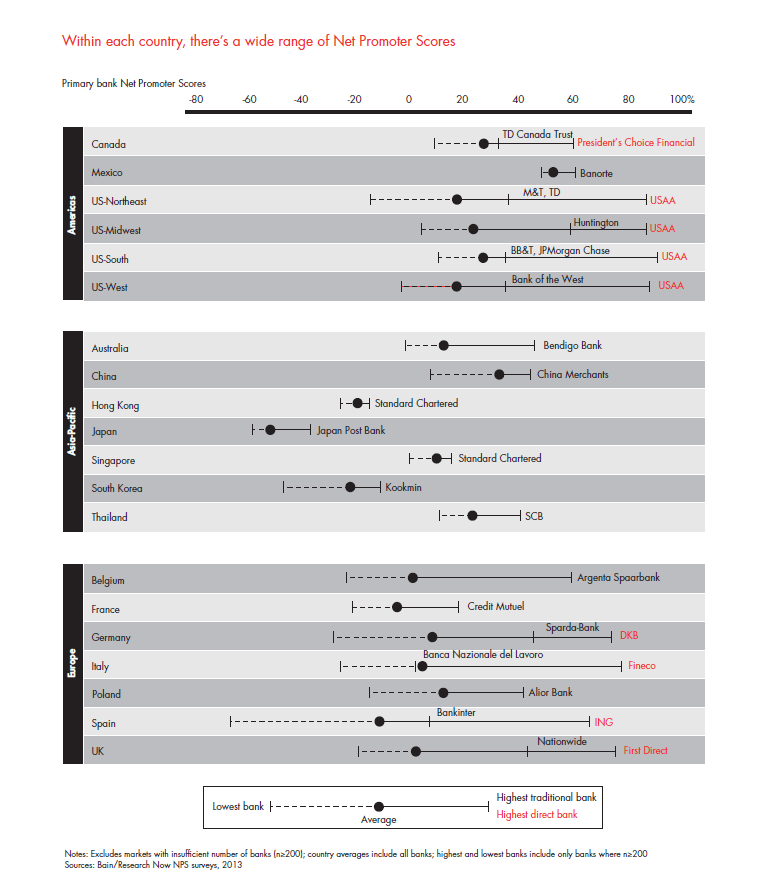
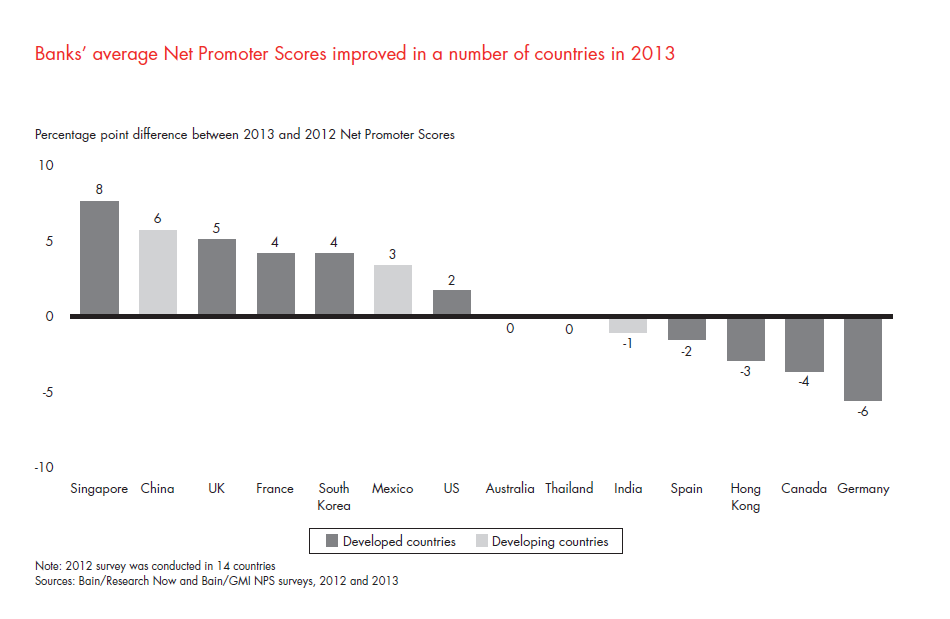
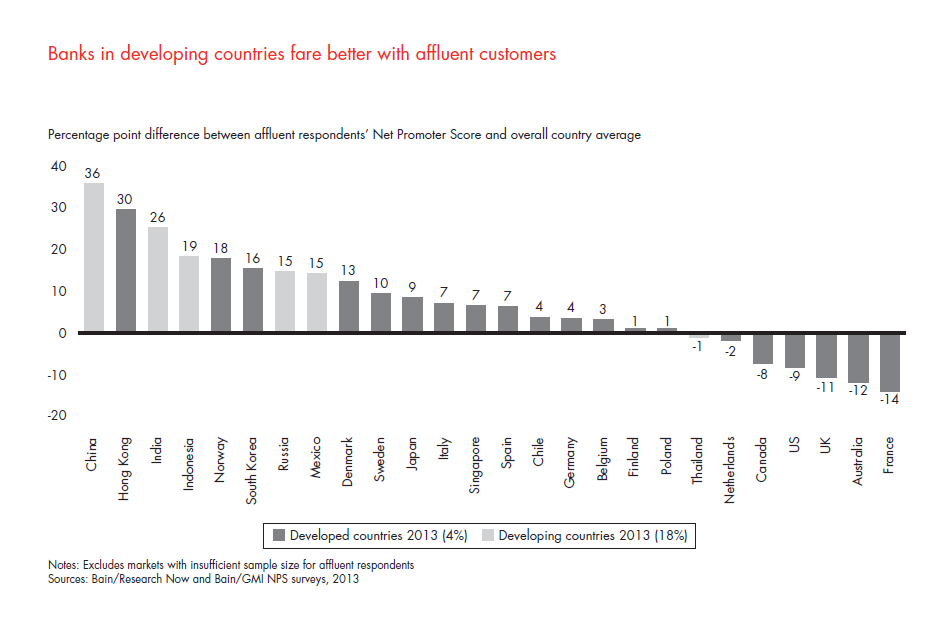
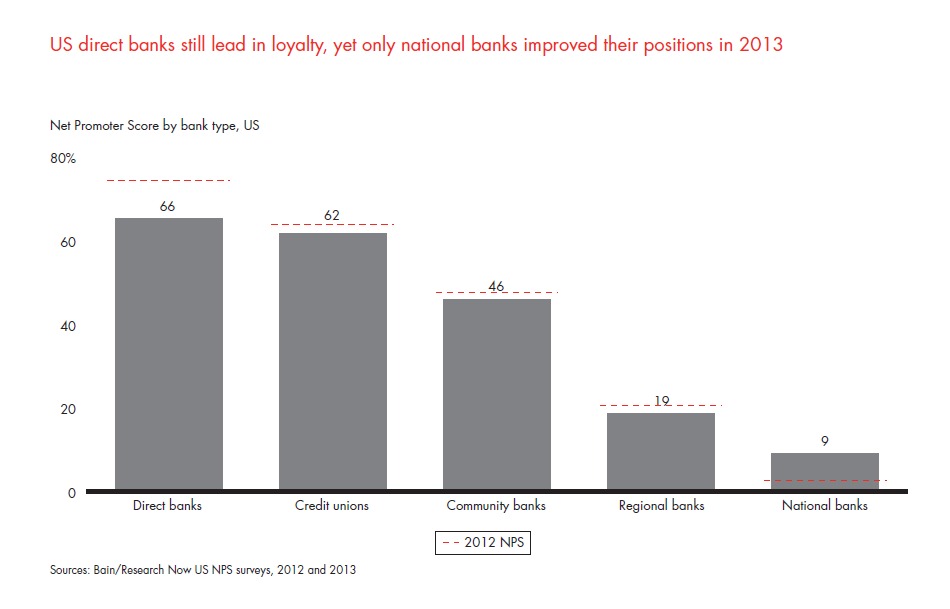
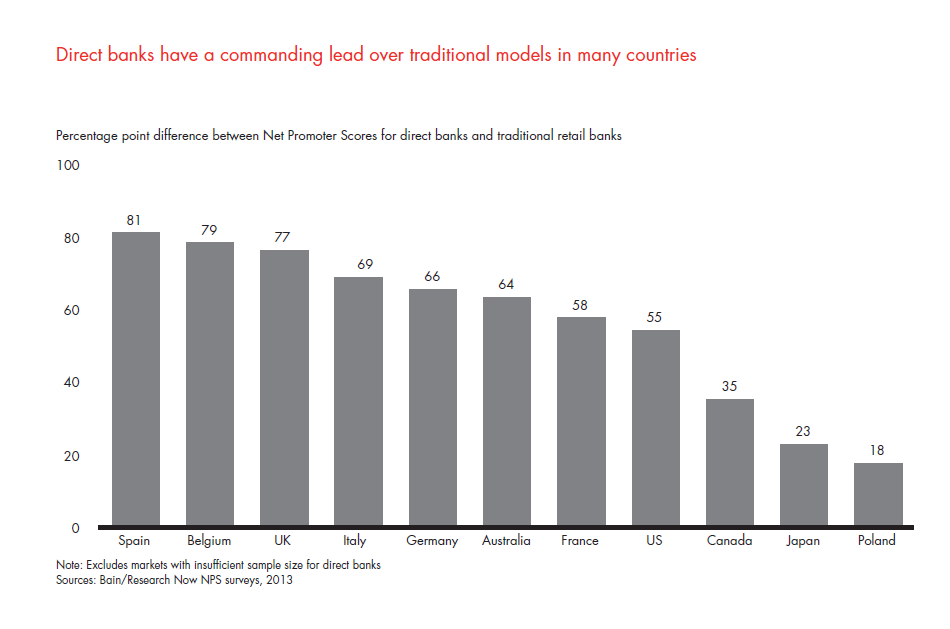
2. Leaders and laggards in the shift to omnichannel
- Banks everywhere are expanding digital channels, but the pace of engagement varies dramatically. The Nordic countries lead in the share of digital banking interactions, while a number of Asian countries lag.
- Generational differences in digital usage persist. For example, some 18% of US customers under age 35 opened an account online, twice as many as customers over age 55.
- Countries vary in the pace of their evolution to deploy each type of channel to advantage. Some countries, particularly the Nordic countries, have made significant progress in steering routine transactions out of the branch and into lower-cost, self-service digital channels, including smart ATMs.
- Within most countries, individual banks vary widely in their progress to move the routine to digital channels and refocus the branch on sales and high-value service. In Spain, for instance, Bankinter leads the least digital bank by 25 percentage points.
- When it comes to account opening, direct banks excel in handling the task online. Yet among other banks, account opening still occurs mostly in the branch, though that’s shifting to the phone in the UK, Germany and the Netherlands.
- Experiments with branch features and layout abound. Raiffeisen’s flagship branch in Zurich offers advanced technologies such as a robotic retrieval system for round-the-clock access to safety deposit boxes. Other banks have launched branches that resemble lounges or cafes, either to complement a strong direct bank presence or to encourage high-value relationships.
- ATMs play an outsize role in Japan, Indonesia, Russia and Singapore. In a few places like Singapore, more versatile ATMs make customers’ lives easier by allowing them to buy airline tickets or pay parking fines
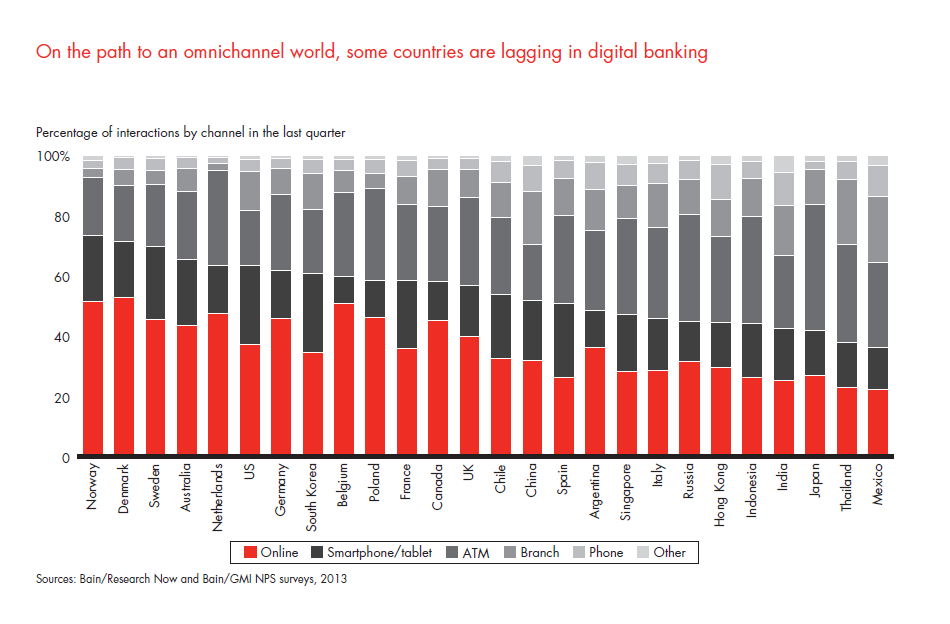
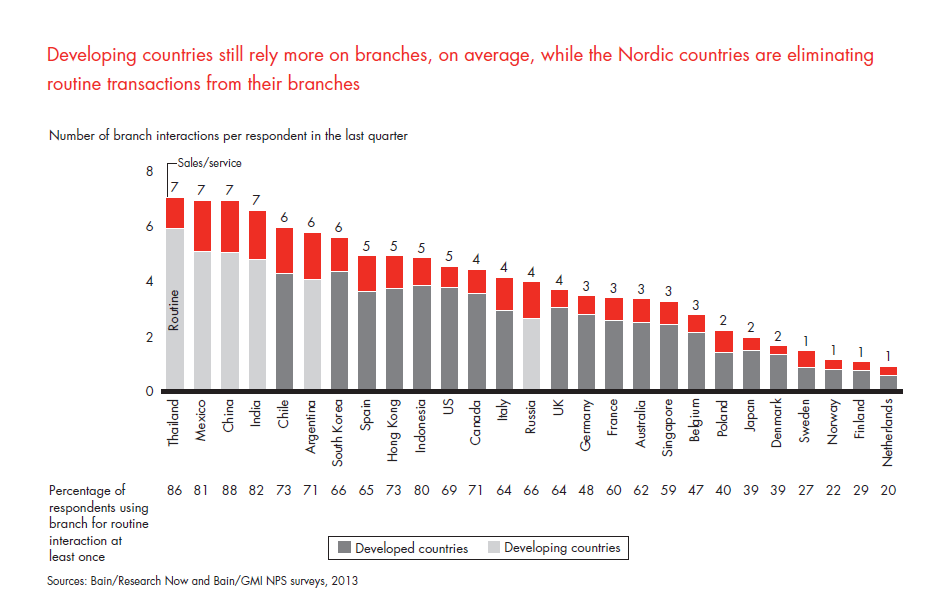
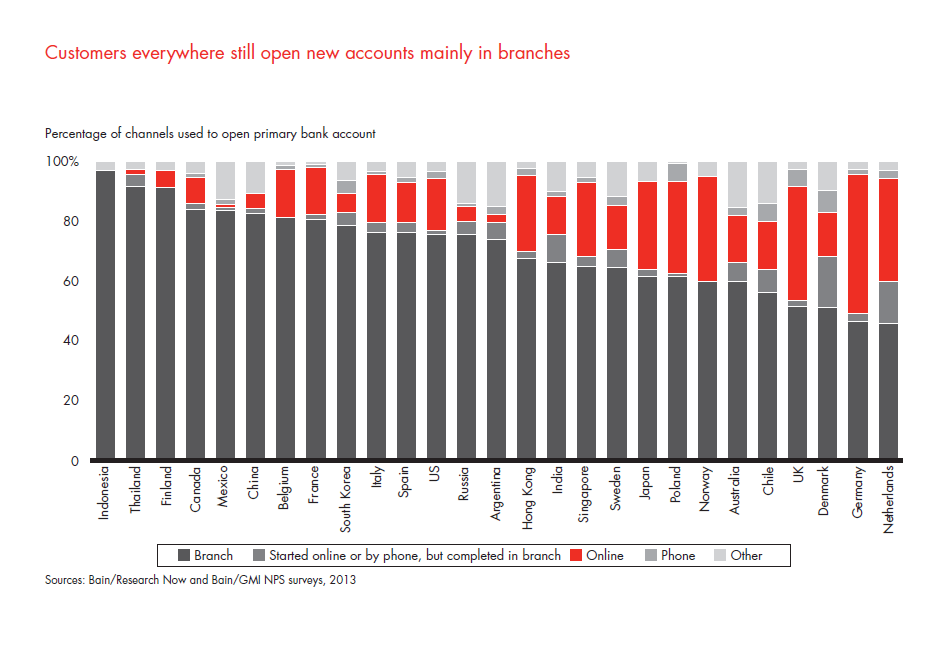
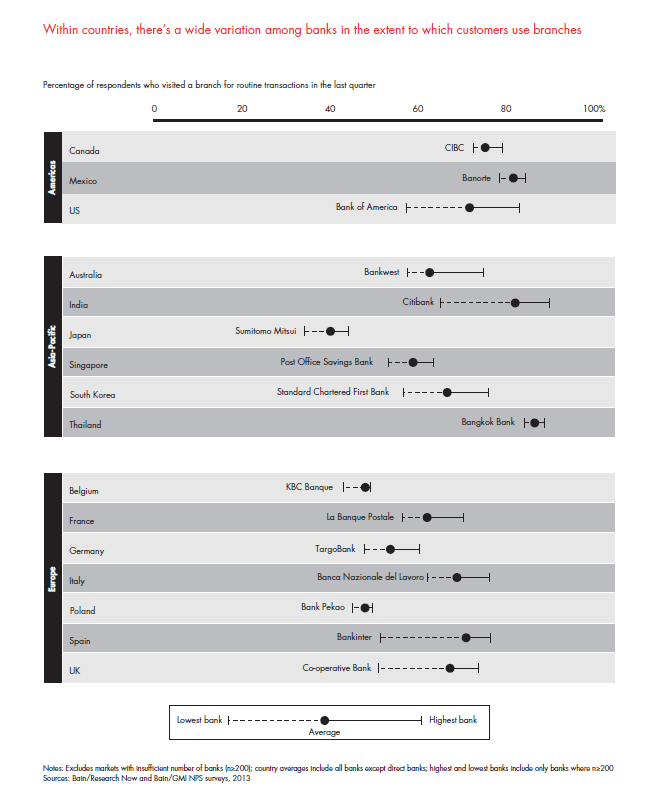
3. Mobile banking expands its mainstream appeal
- Across the globe, mobile banking continues to spread. Customers have embraced banking on their smartphones and tablets when banks offer applications that are both useful and easy to navigate.
- Commonwealth Bank of Australia, for example, offers a versatile mobile platform that allows customers to trade stocks, pay third parties using their mobile number or email, and explore visual and written details of homes for sale.
- China, Chile, South Korea and India have leapfrogged other countries that lag in mobility, like Belgium, Japan and Canada. In general, the developing countries have forged further ahead, and several have more than half of their respondents using mobile channels. They show an especially big lead in mobile payments, with almost twice the level of activity as developed countries.
- Within a given country, however, there’s a wide dispersion in mobile uptake. And not all of the mobile leaders are direct banks. Citibank in India has a higher mobile penetration than Comdirect in Germany and Fineco in Italy. In the US, Chase leads among traditional banks. It invested heavily in mobile technology such as smartphone payments, and its recent advertising highlights how the technology simplifies people’s lives.
- Regardless of bank model, frequent mobile users consistently report higher NPS than non-users. The greatest gap in NPS between the two groups occurs in China, Japan and Thailand, while the narrowest gap is found in Belgium, France and the Netherlands.
- Mobile banking has risen among all age groups and income levels. But younger customers rank as the most avid users, especially in Australia, the US, India and Sweden.
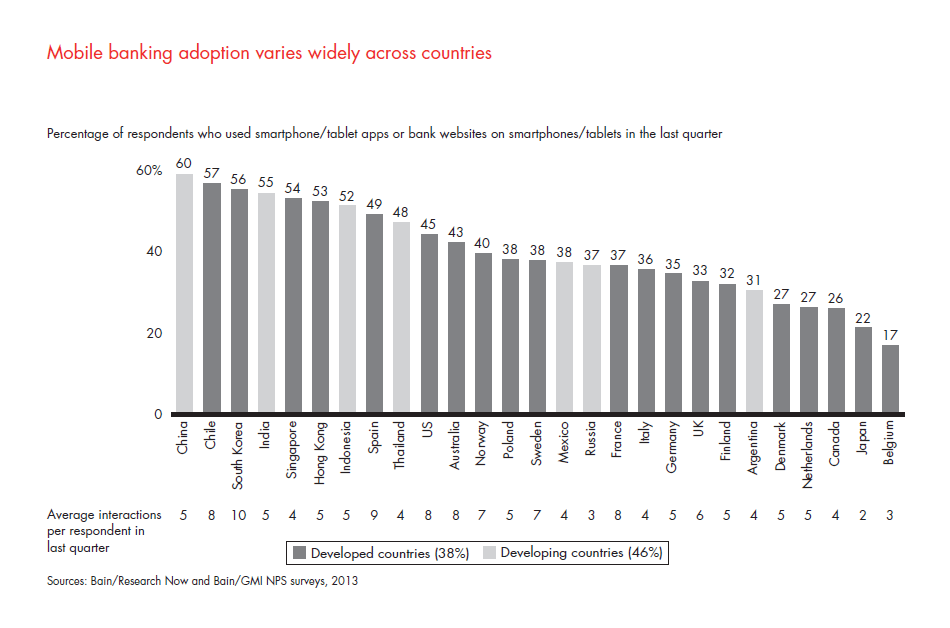
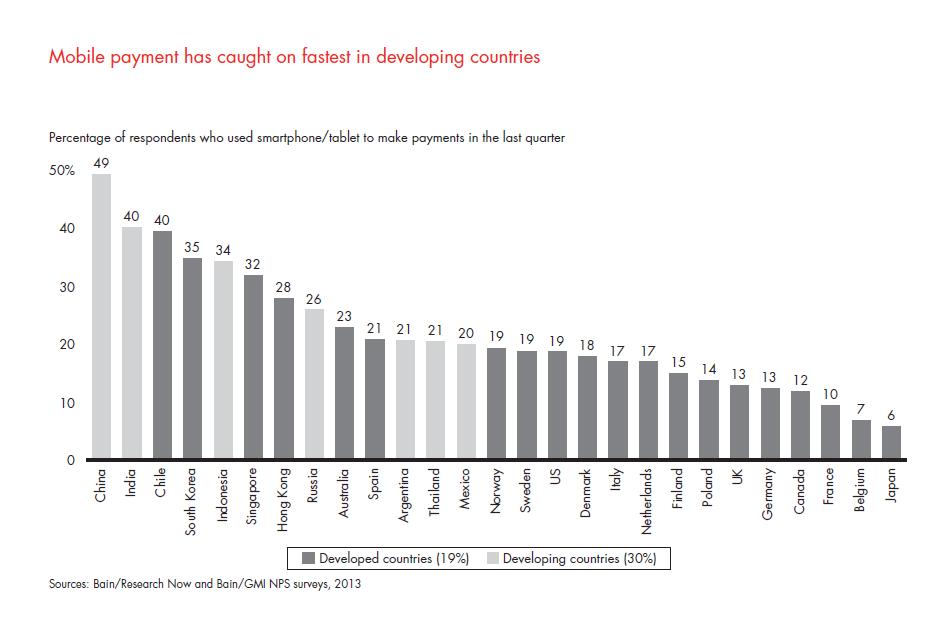
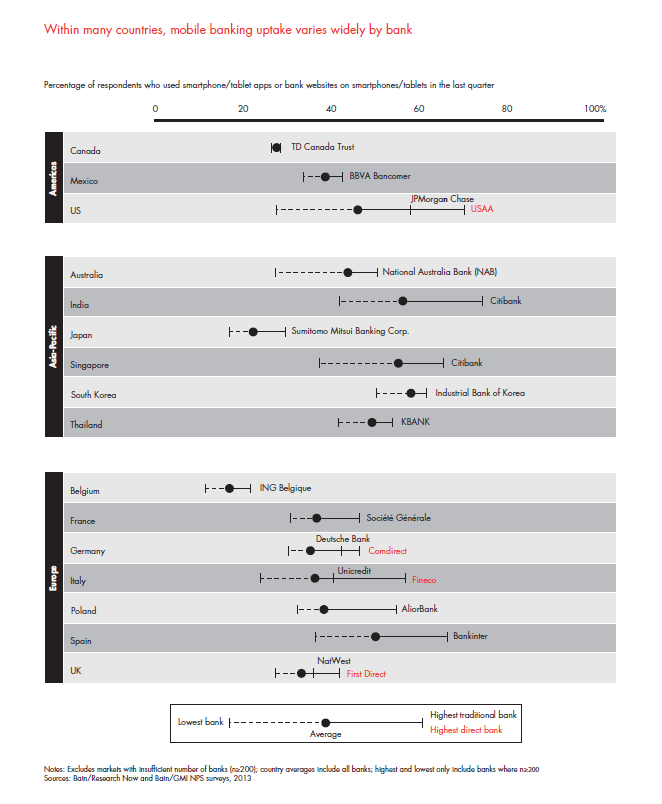
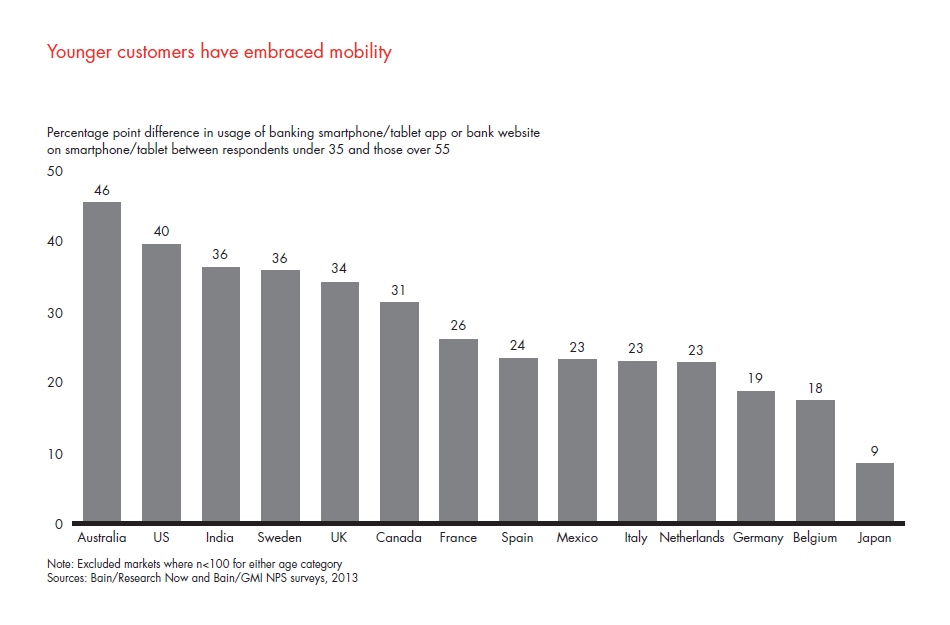
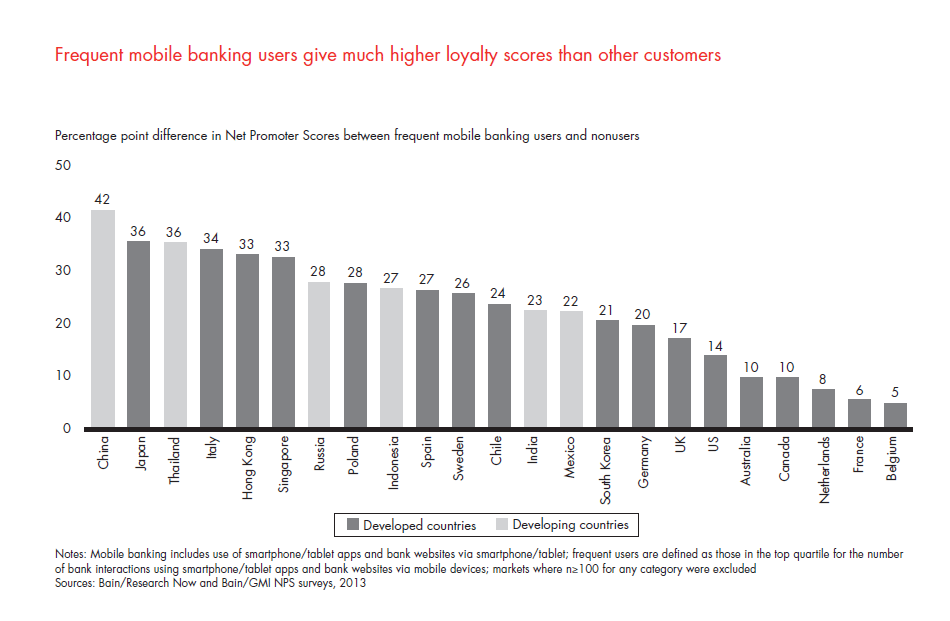
4. The battle for scarce new customers
- New banking relationships—people either new to banking or switching their primary relationships from another bank—are hard to come by. Only 0.7% of respondents were new to banking in the developed world, with another 2.5% switching from their primary bank.
- Still, winning an outsize proportion of primary relationships, anchored on the basic checking or current account, remains an important goal because of the annuity value of cross-selling other products. Our survey finds that respondents hold roughly three other products with their primary bank besides the basic account.
- A bank’s current NPS strongly predicts its success in winning these new relationships. NPS explains about half of the variance among banks in relative win rate (a bank’s win of switchers plus first-time joiners, relative to its share of primary customers).
- New customers can be won in many ways. ING in Spain does it largely by developing strong product packages, targeted to particular segments such as university students.
- Besides loyalty, what it takes to win new relationships differs by country. Respondents who chose a new bank most commonly cited fees, ease of account opening and branch locations as the reasons. Interest rates also were a major factor in several markets, including the UK, Sweden and Singapore. And ATM locations ranked high in Argentina, Hong Kong, Indonesia and Japan.
- Preventing attrition arguably outweighs winning new relationships, given the slow rate of new account formation. In the US, banks could have headed off most of the switching, because three-fifths of customers cited factors such as high fees and poor service. Less than one-fifth of switching resulted from customers taking better offers from other banks.
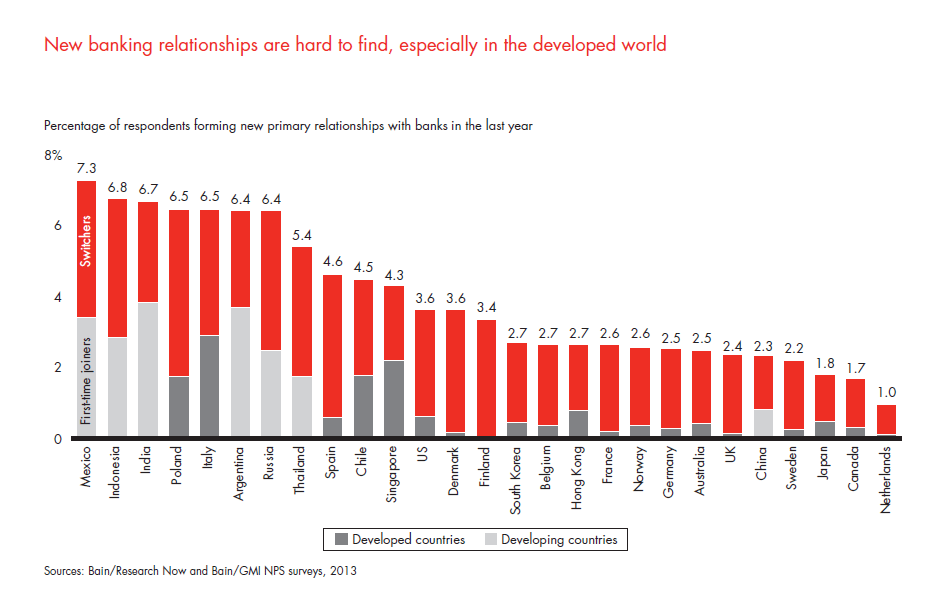
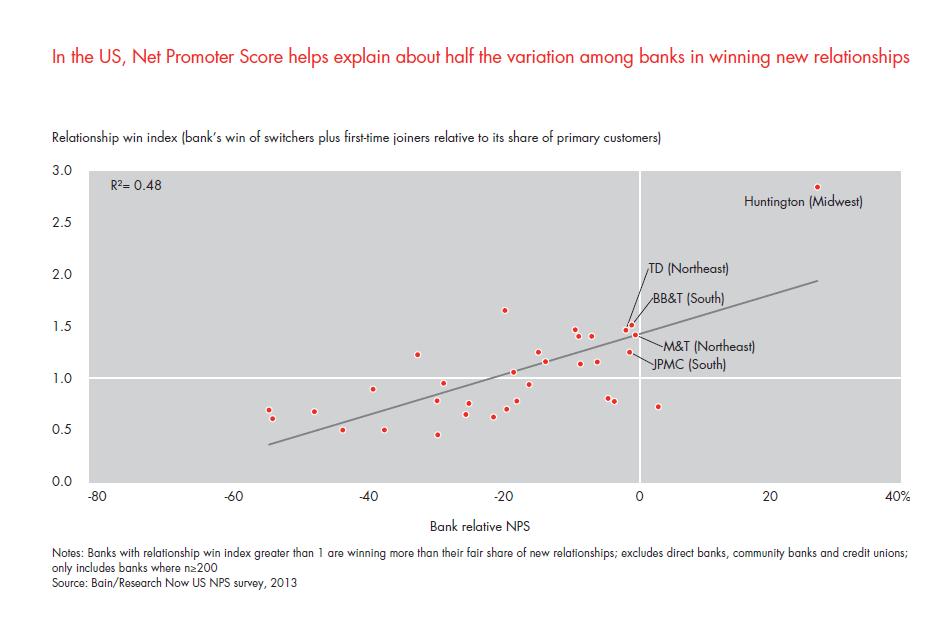
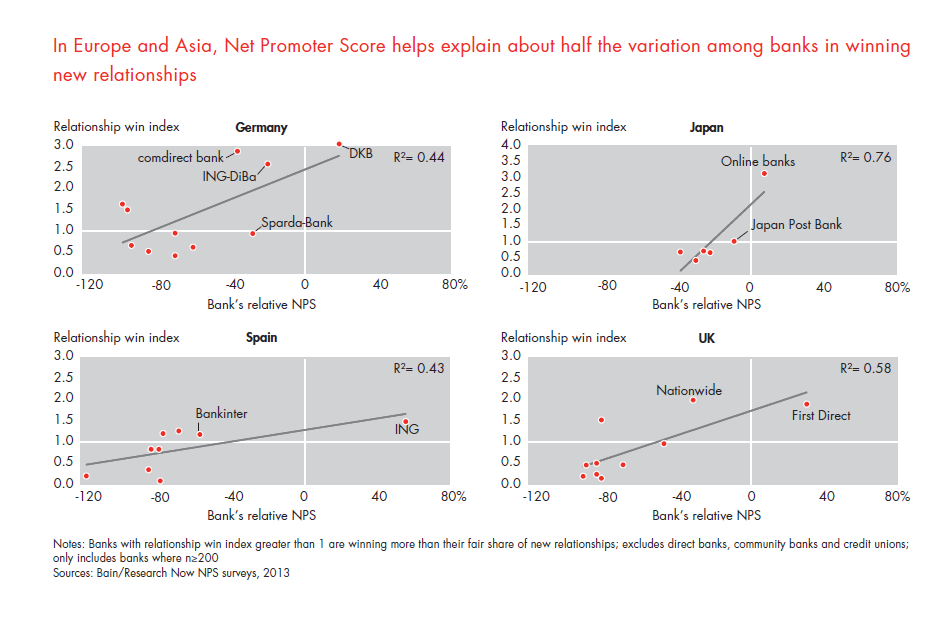
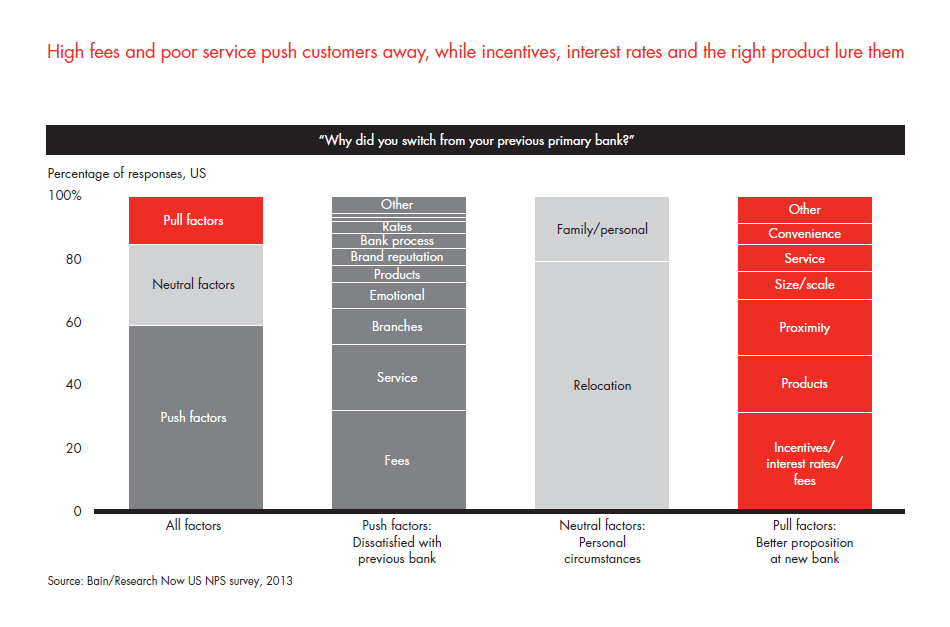
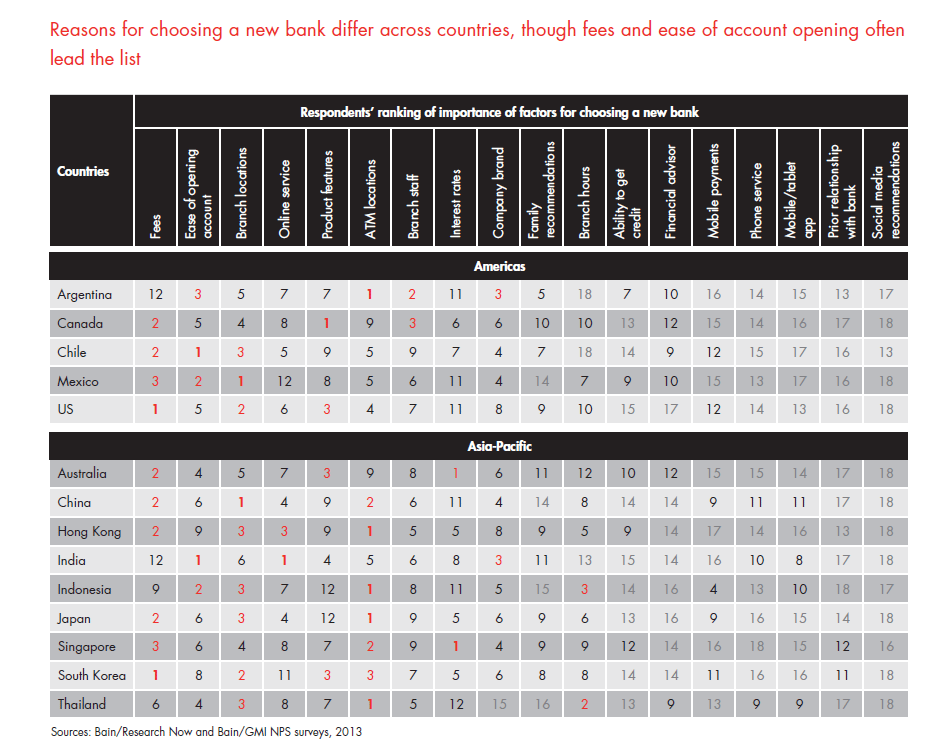
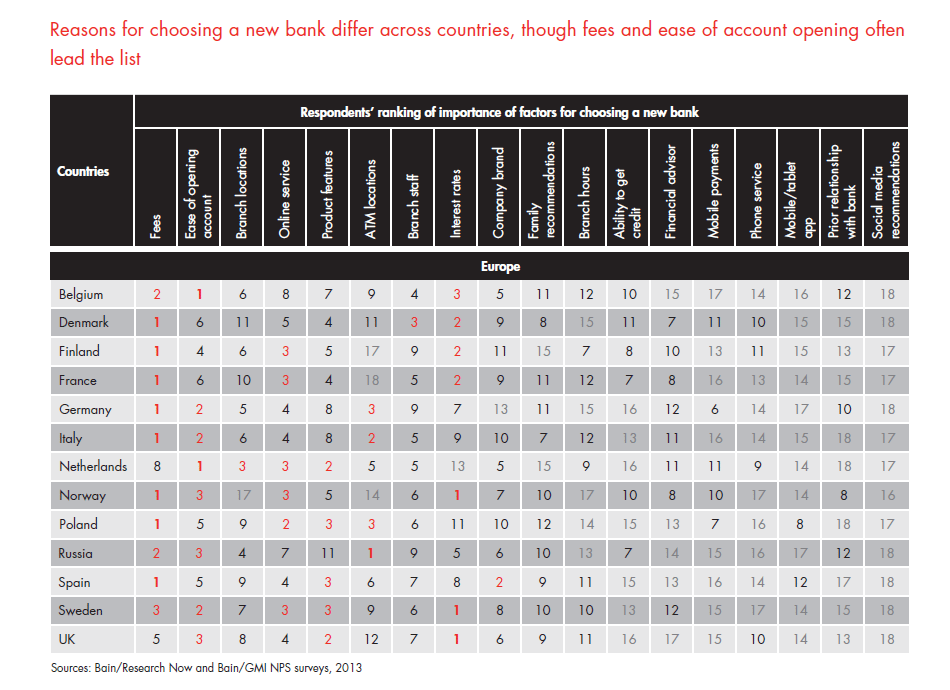
5. Cross-selling: The golden opportunity
- A surprisingly large opportunity exists to sell new products such as credit cards to existing customers. In the developing countries, 83% of respondents purchased a new product over the past year; in the developed countries, 50% did.
- While the primary bank captures most of these new products, on average, 35% of new product sales go to a competitor. The competitors’ share ranges from 19% in Denmark, which has a very concentrated banking sector, to a remarkable 60% in the UK and 54% in Germany, where the global trend to unbundle product holding has gone further. The UK and German markets have many specialized challenger banks, as well as customers who have a low regard for large banks after the crisis and, in Germany, who are highly price sensitive.
- Cross-selling performance varies even more by bank within countries. In Canada, for instance, RBC has a win rate of more than two times the least effective bank, and Santander has a similar lead in the UK.
- While many factors account for this difference in performance, customer loyalty has a big influence on a bank’s current cross-selling performance and its future potential. Customers who are promoters of their primary bank buy more from that bank than detractors do. In developing countries, the NPS gap between the two groups of customers amounts to 9 percentage points; in developed countries, the difference is 14 points.
- Consider banking products in China. Some 61% of promoters have bought an auto loan from their primary bank, vs. just 31% of detractors. The spread is similar for life insurance and wealth and investment products.
- The higher cross-sell rates that result from stronger loyalty lead to broader product holdings with the primary bank as well. Promoters hold on average 68% of products with their primary bank vs. 60% for detractors.
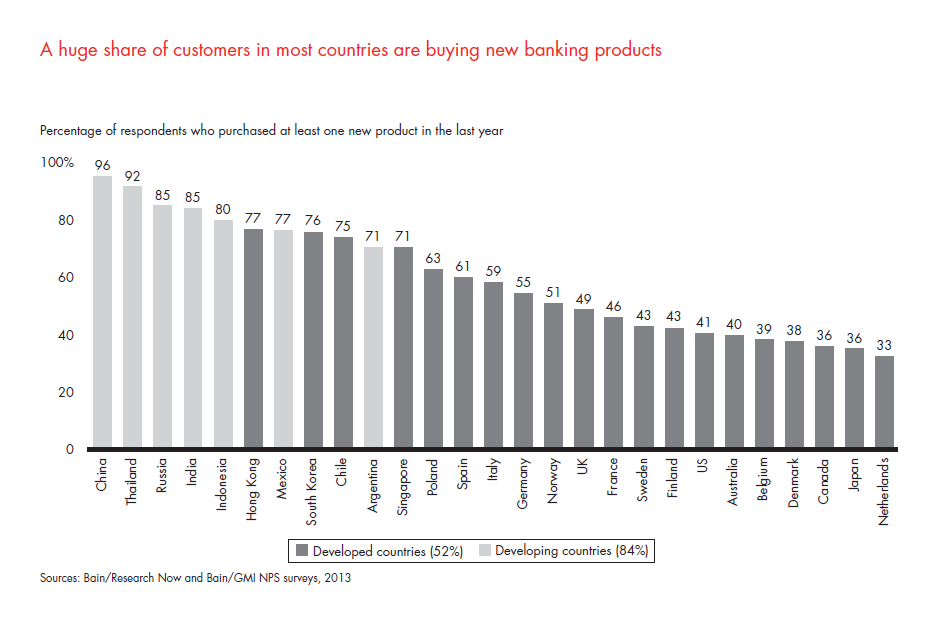
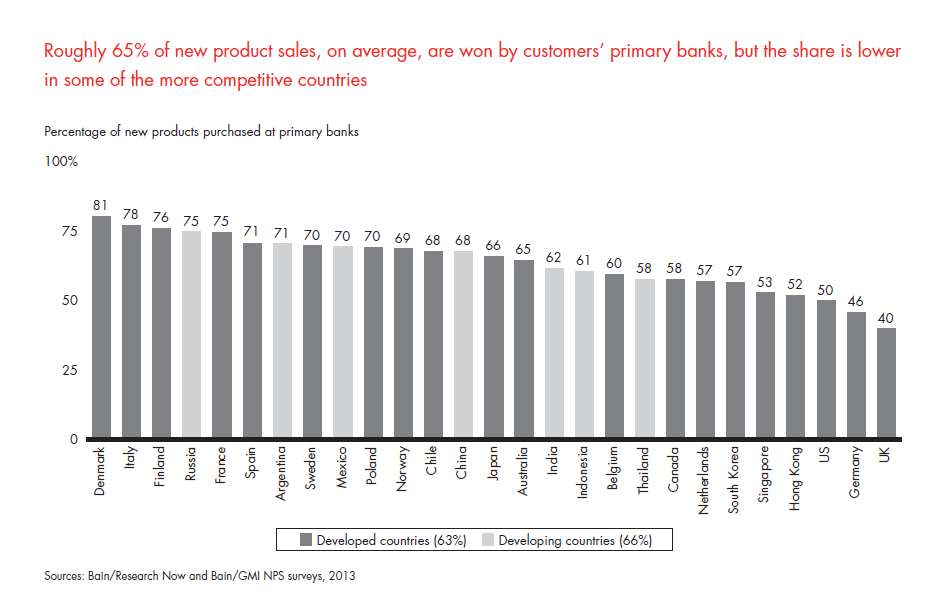
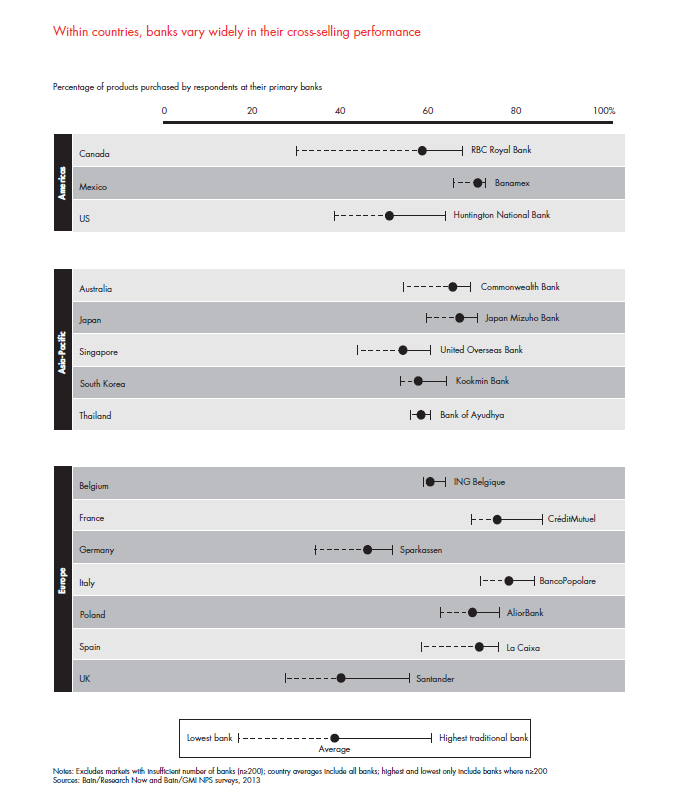
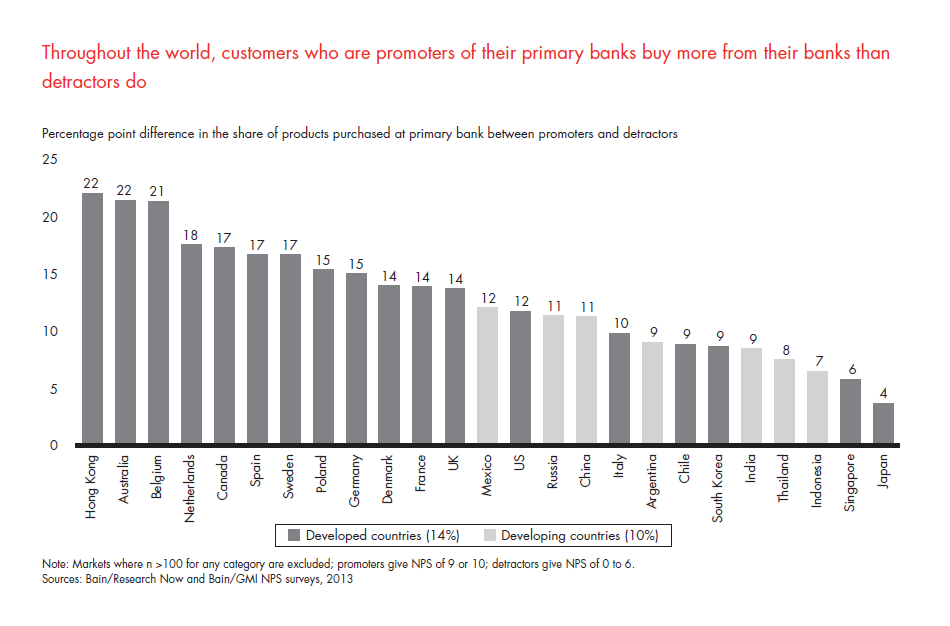
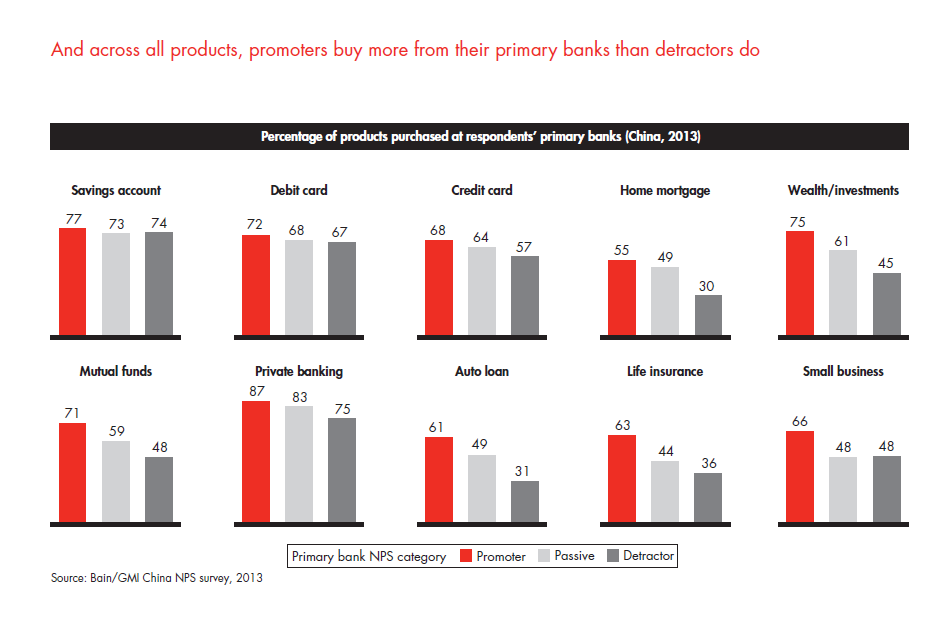
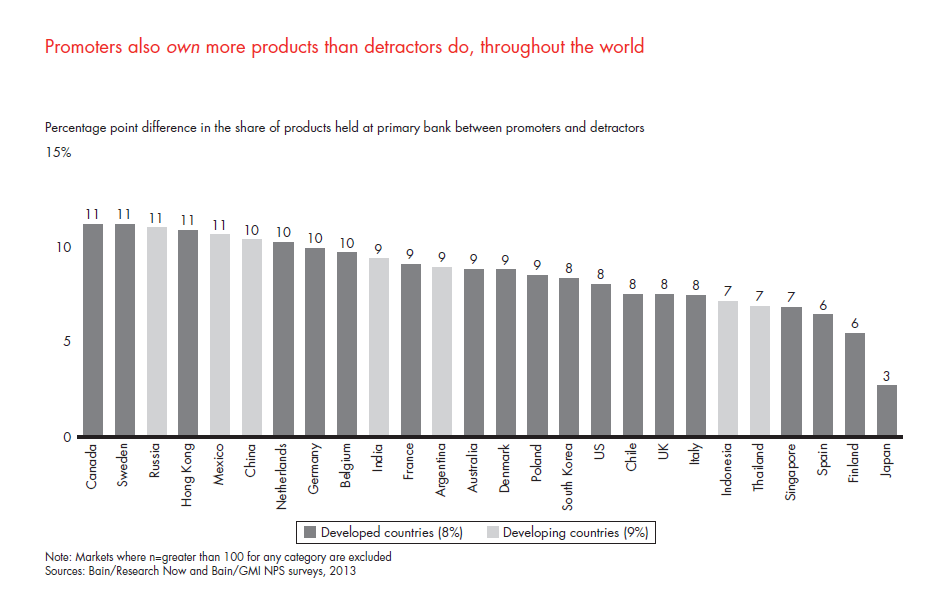
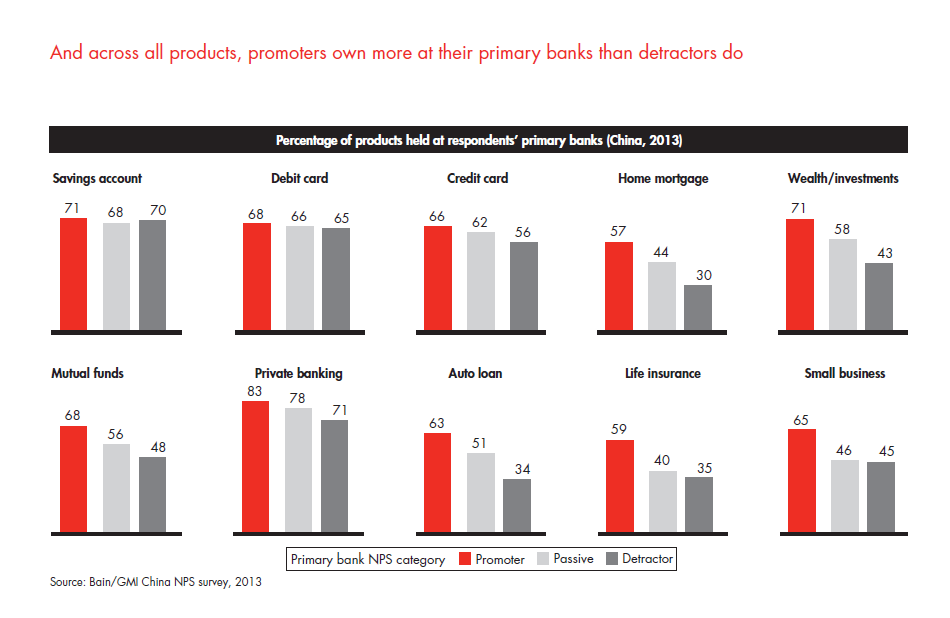
6. Five ways to realize the fruits of loyalty
- Winning new customers, limiting attrition and seizing the cross-sell opportunity all start with a bank’s ability to earn loyalty. But the experiences of leading banks show that five other elements are required in order to generate outsize growth.
- These start with insightful and practical customer segmentation schemes. In the US, younger customers place far more importance on recommendations from others and on mobile tools than older customers, who care relatively more about branch location and helpful staff.
- Banks must also ensure that they have a competitive suite of products. In the US, no traditional bank ranked highest on more than one product, so they clearly have room to improve.
- Selling capabilities are critical. In the US, roughly one-third of products get sold, not bought. The leading bank performs two to five times better than the laggard, depending on the product category.
- Service stands as the dominant cause of loyalty in most markets. To delight customers these days, the banking experience must be consistent and seamless in person, online, on mobile and on the phone, because customers increasingly hop among channels to complete a task.
- Finally, these four capabilities should reinforce and be supported by the bank’s brand and reputation. USAA has one of the strongest brands in banking despite its modest investment in advertising, in part because it serves such a specific, homogeneous group of customers—the military, veterans and their families—and consistently delivers on the brand promise.
- In general, loyalty leaders outperform on both win rates for new relationships and cross-selling to existing customers. Banks that have advanced on several of the five elements thus have started to translate loyalty to better economics.
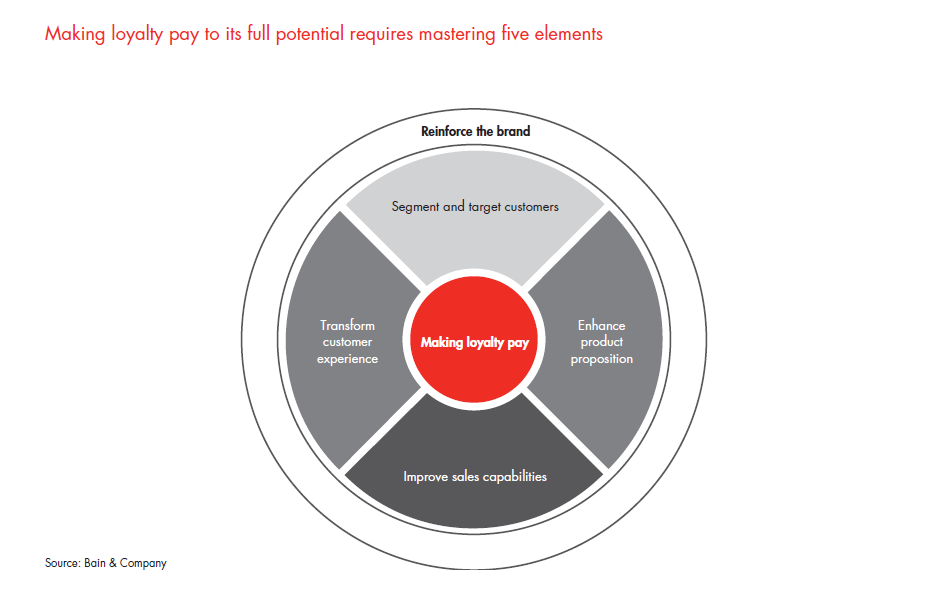
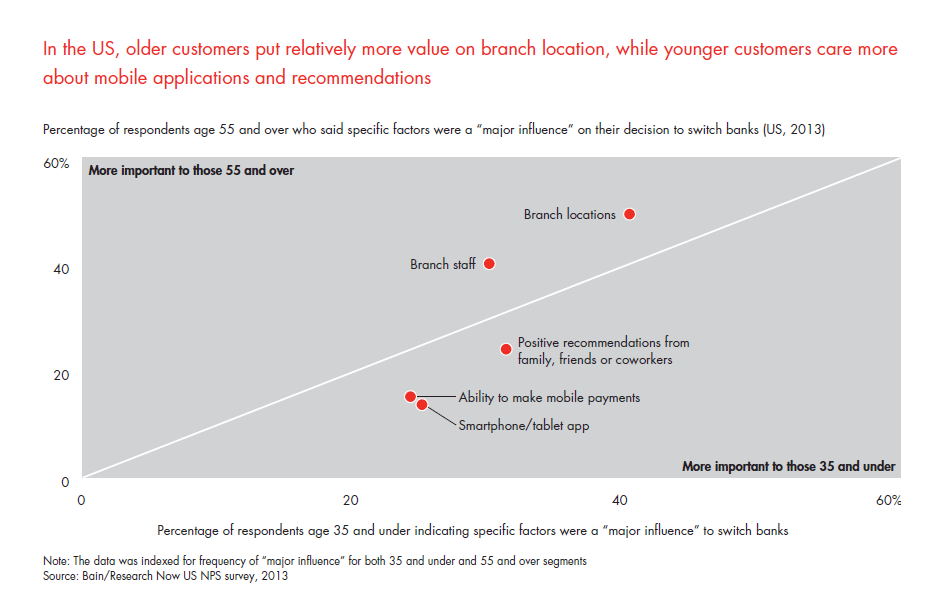
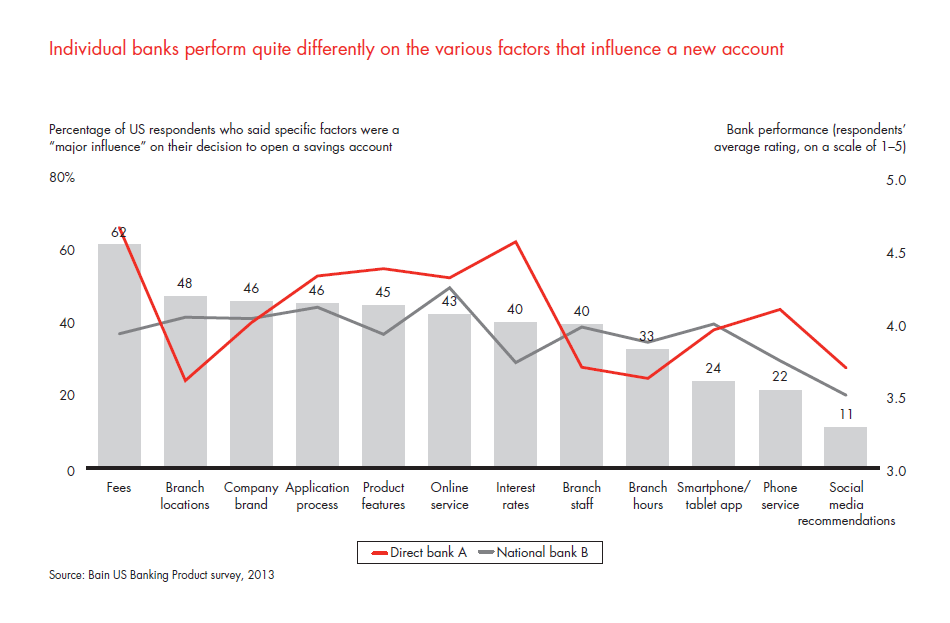
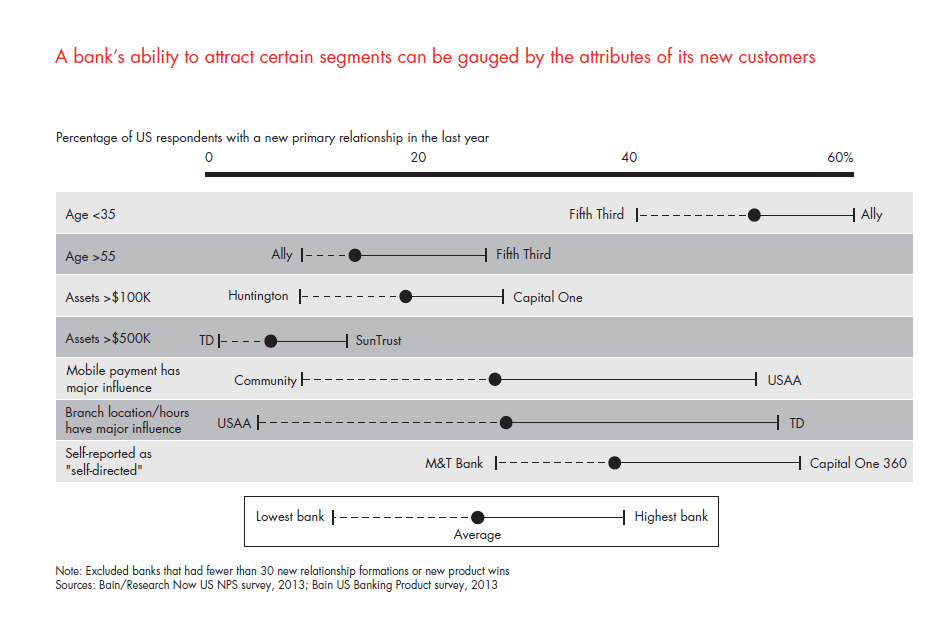
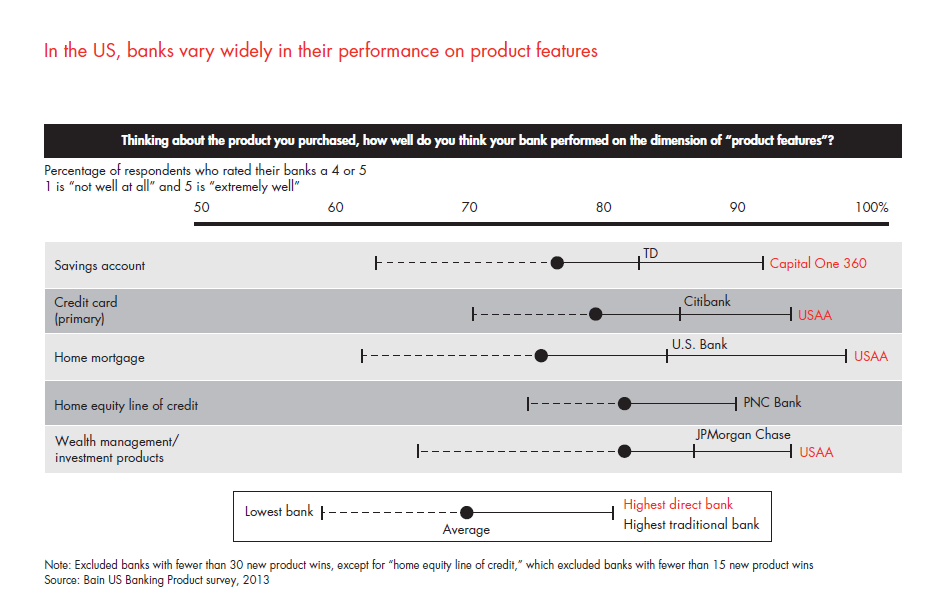
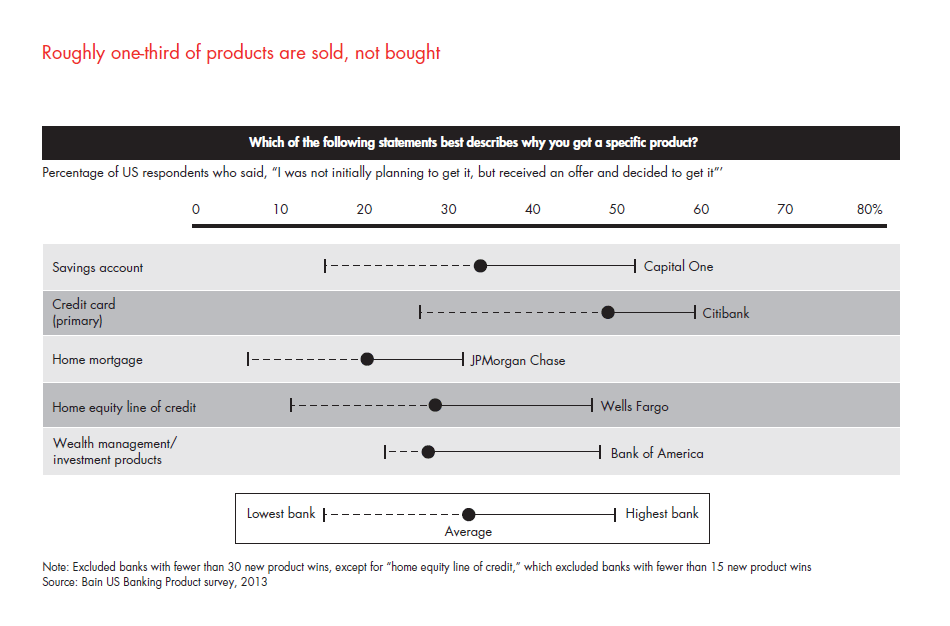
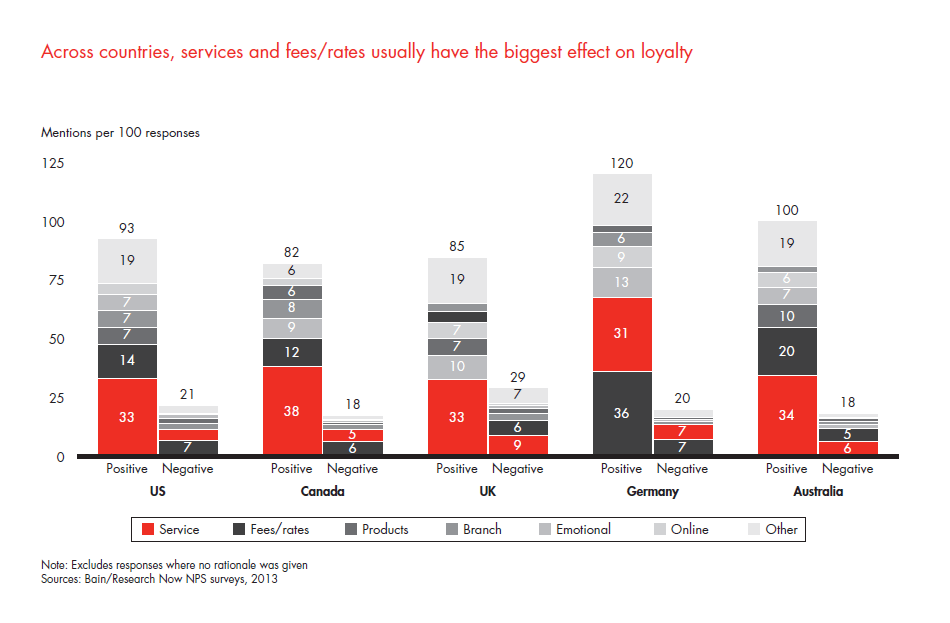
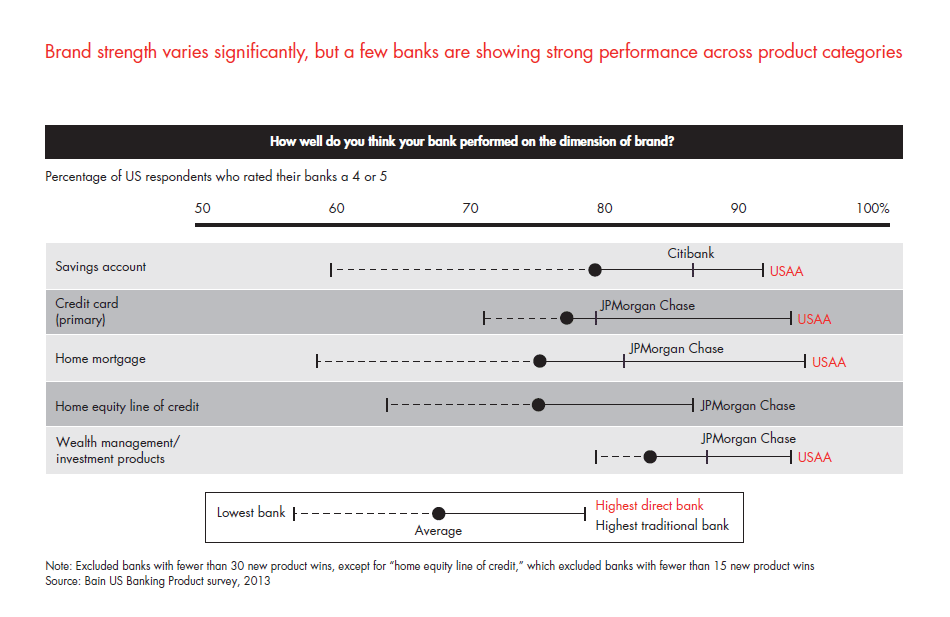
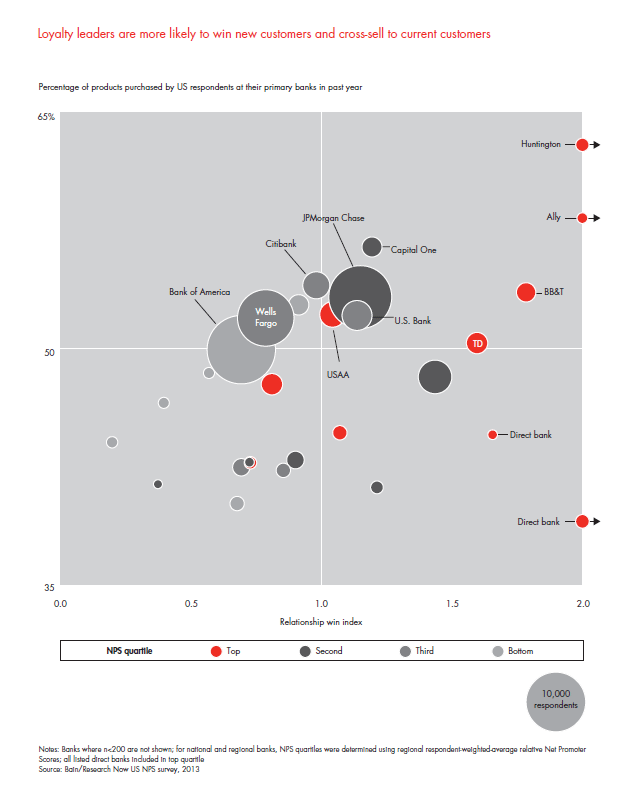
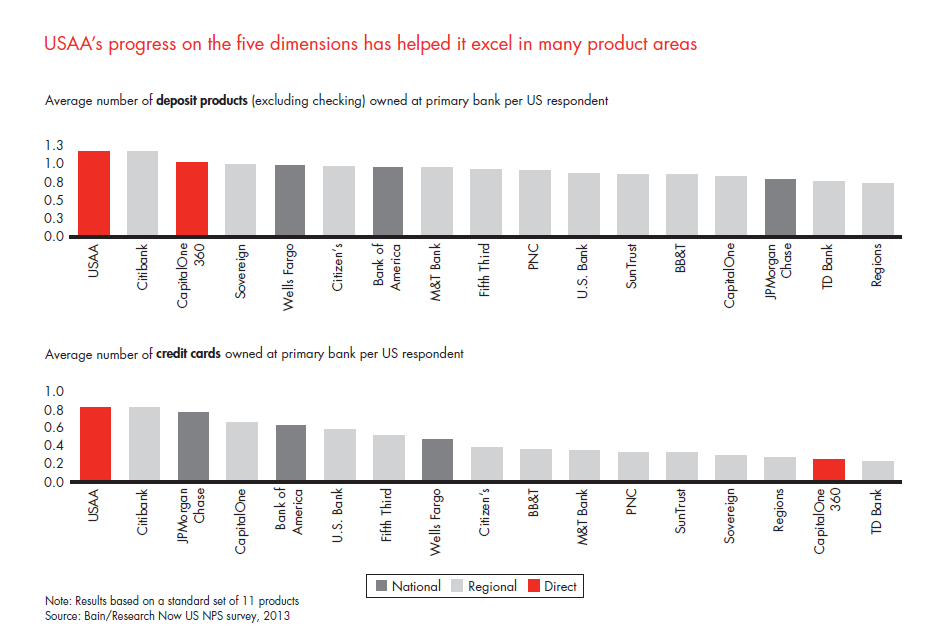
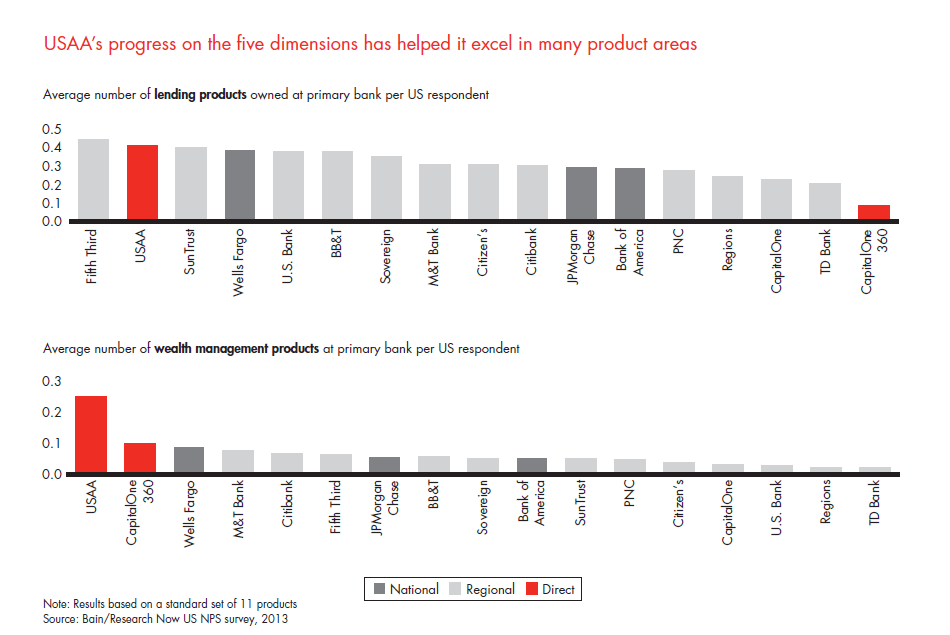
Appendix: Methodology
Bain & Company partnered with Research Now, the online global market research organization, to survey consumer panels in Argentina, Australia, Belgium, Chile, Canada, Denmark, Finland, France, Germany, Italy, Japan, Mexico, the Netherlands, Norway, Poland, Russia, Spain, Sweden, the UK and the US. The survey’s purpose was to gauge customers’ loyalty to their principal bank and the underlying reasons they hold the views they do. Conducted in the summer of 2013, the survey polled 177,937 customers of national branch network banks, regional banks, private banks, direct banks, community banks and credit unions in these countries. We included in the individual bank analysis only those banks for which we received at least 200 valid responses, though in many countries, sample sizes exceeded 200 for each bank included.
Bain worked with GMI to survey a further 12,251 account holders in China, Hong Kong, India, Indonesia, Singapore, South Korea and Thailand. Similarly, individual bank Net Promoter Scores are based on the responses of at least 200 participants.
Survey questions
Respondents were first asked to identify their primary bank, after which they were asked the following three questions to assess their loyalty to that institution:
- On a scale of zero to 10, where zero represents “not at all likely” and 10 represents “extremely likely,” how likely are you to recommend your primary bank to a friend or relative?
- Tell us why you gave your primary bank the score you did.
- How long have you used this bank as your primary bank?
If respondents had been with their current primary institution for less than a year, they were asked to identify whether they were new to banking or if they had switched from another institution. We subsequently asked about their prior primary banking relationship, why they switched banks, what influenced them in their choice of a new bank and which channel they used to open their new account.
For all survey respondents, we asked what major products they hold with their primary bank and other banks, and which of these products were purchased in the last year. We also asked which channels they use to do their banking. The remaining questions elicited demographic profile information on household income, investable assets and region of residence.
We followed up with 5,200 US respondents to ask more detailed questions about their purchase of specific products, including their product NPS, the methods they used to research their purchases, the channel they used to purchase the product, the major factors that influenced them in the purchase of the product and how the bank performed on those factors. For those people who did not purchase from their primary bank, we asked reasons for purchasing elsewhere.
On the question of statistical significance, the results of our data analysis are robust both for the measurement of bank NPS by country and for respondent NPS for each demographic category. The NPS measured for each bank included in the US regional rankings is statistically significant to an 80% confidence level, with a two-tailed test of the confidence interval ranging from plus or minus 1.5% (n=4,500) to plus or minus 6.8% (n=201). In countries where sample sizes were smaller, confidence intervals are wider, with a maximum of plus or minus 7.5%.
Countries classified as developed are based on the World Bank’s high-income category; the developing countries are based on its middle- and low-income categories.
Acknowledgments
This report was prepared by Gerard du Toit and Maureen Burns, partners in Bain’s Financial Services practice, and a team led by Christy de Gooyer, a practice area manager. The authors thank Bain partners in each of the countries covered in the report for their valuable input and John Campbell for his editorial support.





































